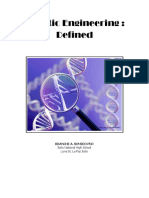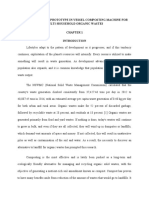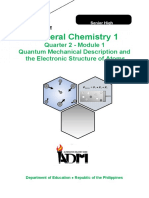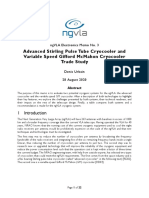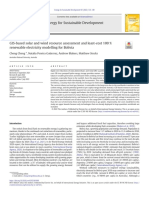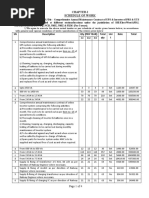G12 Chemistry Adv-Topic 1-Practice Questions AK (AY 20-21)
G12 Chemistry Adv-Topic 1-Practice Questions AK (AY 20-21)
Uploaded by
Ebtisam AlmenhaliCopyright:
Available Formats
G12 Chemistry Adv-Topic 1-Practice Questions AK (AY 20-21)
G12 Chemistry Adv-Topic 1-Practice Questions AK (AY 20-21)
Uploaded by
Ebtisam AlmenhaliOriginal Description:
Original Title
Copyright
Available Formats
Share this document
Did you find this document useful?
Is this content inappropriate?
Copyright:
Available Formats
G12 Chemistry Adv-Topic 1-Practice Questions AK (AY 20-21)
G12 Chemistry Adv-Topic 1-Practice Questions AK (AY 20-21)
Uploaded by
Ebtisam AlmenhaliCopyright:
Available Formats
Grade 12 – CHM 71
Topic 1 – Practice Questions – AK
Subtopic 1.1 – Energy and the flow of Energy
1. Which of the following is/are a form of energy that flows from a warmer to a cooler object?
I. Temperature
II. Pressure
III. Heat
A. I only
B. II only
√ C. III only
D. I and II only
2. Which of the following is/are not a unit of temperature?
I. K
II. °C
III. J/K
A. I only
B. II only
√ C. III only
D. I and II only
3. Which of the following can be expressed in J/K.mol?
A. Entropy
B. Gibb’s free energy
√ C. Molar heat capacity
D. Specific heat capacity
4. What is the amount of heat absorbed by 5.00 g of water when heated from 2.00℃ to 22.0℃?
(Specific heat capacity of water = 4.18 J/g.oC)
A. 41.8 J
B. 100. J
√ C. 418 J
D. 460. J
Topic 1 – Practice Questions AK 1 Grade 12 – CHM 71
Use the following information to answer questions 5 – 7.
A student mixed 10. g of calcium carbonate pebbles, CaCO3, with 50. mL of 1.0 M hydrochloric aicd
solution, HCl, in a conical flask as shown in the figure below.
5. Which of the following is/are part of the system in this experiment?
A. Conical flask and HCl
√ B. CaCO3 pebbles and HCl
C. CaCO3 pebbles only
D. Conical flask only
6. Which of the following is/are part of the surroundings in this experiment?
A. Conical flask and HCl
B. CaCO3 pebbles and HCl
√ C. Conical flask only
D. HCl solution only
7. Which of the following is/are part of the universe in this experiment?
I. Air
II. Conical flask
III. HCl solution
IV. CaCO3 pebbles
A. I only
B. I and II only
C. I, II and III only
√ D. I, II, III and IV
Topic 1 – Practice Questions AK 2 Grade 12 – CHM 71
8. When a reaction releases heat, the energy changes from __________ and it will be described as a(n)
______ reaction.
A. heat to chemical potential endothermic
√ B. chemical to heat exothermic
C. potential to thermal endothermic
D. heat to potential exothermic
9. When a reaction absorbs heat, the energy changes from __________ and it will be described as a(n)
______ reaction.
√ A. heat to chemical potential endothermic
B. chemical to heat exothermic
C. potential to thermal endothermic
D. heat to potential exothermic
10. How much heat is required to raise the temperature of 45.00 g of water from 40.0℃ to 70.0℃?
(Specific heat capacity of water is 4.18 J/g℃)
A. 2.786 J
B. 10.45 J
C. 1350. J
√ D. 5643 J
11. Thermochemistry is the study of ___________________.
A. reaction rates
B. combustion reactions
C. stoichiometry relationships
√ D. heat transfer during reactions
Topic 1 – Practice Questions AK 3 Grade 12 – CHM 71
12. A sample of glass that has a mass of 6.0 g gives off 12 J of heat. If the temperature of the sample
changes by 4.0C during this change, what is the specific heat of the glass?
√ A. 0.50 J/g.℃
B. 1.0 J/g.℃
C. 2.0 J/g.℃
D. 3.0 J/g.℃
13. A 34.4 g sample of ethanol (Specific heat capacity 2.44 J/g.℃) increases from 25.0oC to 78.8oC. the
amount of heat absorbed by ethanol is ______________ J.
A. 1.20 × 103
B. 2.10 × 103
√ C. 4.52 × 103
D. 6.6.1 × 103
14. A 155 g sample of substance X was heated from 35.0℃ to 50.0℃. During the process, the
substance absorbed 5696 J. Answer questions a and b.
a) Calculate the specific heat capacity of substance X.
Q = m × c × ∆T
5696 = 155 × c × (50.0 – 35.0)
c = 2.45 J/g.℃
b) Which of the following chemical could be substance X? Tick one box only.
Ice, 2.03 J/g.℃
Barium, 0.204 J/g.℃
Ethanol, 2.44 J/g.℃ √
15. How much heat is absorbed by a 95 g of ethanol sample (specific heat capacity = 2.419 J/g.℃) to
raise its temperature from 25.0°C to 28.0°C?
Q = m × c × ∆T
= 95 × 2.419 × (28.0 – 25.0)
= 95 × 2.419 × 3.0 = 6.9⨯102 J
Topic 1 – Practice Questions AK 4 Grade 12 – CHM 71
Subtopic 1.2 – Measuring and Expressing Energy Changes
1. A 32 grams of a piece of silver (specific heat capacity = 0.240 J/g.℃) is heated to a temperature of
92°C .The piece of silver was then immersed in an insulated cup containing 25 mL of water
(density of water 1.0 g/mL) at an initial temperature, t.
If the final temperature of the mixture is 41°C, what is the initial temperature, t, in ℃ of the sample
of water?
A. 25
B. 27
√ C. 37
D. 41
2. Which of the following reactions represents the enthalpy of combustion of ammonia gas, NH3?
A. N2 (g) + 3 H2 (g) → 2 NH3 (g)
B. 2 NH3 (g) → N2 (g) + 3 H2 (g)
C. NH4Cl (s) → NH3 (g) + HCl (g)
5 3
√ D. NH3(g) + O2 (g) → NO (g) + H2O (g)
4 2
3. Nitrogen and oxygen gases react to produce nitrogen dioxide gas according to the given
thermochemical equation:
N2 (g) + 2 O2 (g) → 2 NO2 (g) ∆Ho= + 67.6 kJ
Which of the following reactions has an enthalpy of – 33.8 kJ?
A. N2 (g) + 2 O2 (g) → 2 NO2 (g)
1
B. N2 (g) + O2 (g) → NO2 (g)
2
1
√ C. NO2 (g) → N2 (g) + O2 (g)
2
D. N2 (g) + O2 (g) → NO2 (g)
Topic 1 – Practice Questions AK 5 Grade 12 – CHM 71
4. Given the below thermochemical reaction:
4 NO (g) + 6 H2 (g) → 4 NH3 + 2 O2 (g) ∆Ho = +1170 kJ
What is the quantity of heat associated with the consumption of three moles of hydrogen gas?
A. − 585 kJ
B. +117 kJ
√ C. + 585 kJ
D. − 1170 kJ
5. Given the thermochemical equation below, the quantity of heat associated with the formation of
two moles of NH3 (g) is ____________.
4 NO (g) + 6 H2O (g) → 4 NH3 + 5 O2 (g) ∆Ho= + 1170 kJ
A. − 585 kJ
B. + 117 kJ
√ C. + 585 kJ
D. − 1170 kJ
6. Nitrogen and oxygen gases react to produce nitrogen dioxide gas according to the given
thermochemical equation:
N2 (g) +2 O2 (g) → 2 NO2 (g) ∆Ho = + 67.6 kJ
1
What is the enthalpy of the reaction: N2 (g) + O2 (g) → NO2 (g)?
2
A. − 67.6 kJ
√ B. + 33.8 kJ
C. + 65.6 kJ
D. + 67.6 kJ
Topic 1 – Practice Questions AK 6 Grade 12 – CHM 71
7. The reaction below shows the formation of hydrogen bromide gas form hydrogen and bromine
gases.
H2 (g) + Br2 (g) → 2 HBr (g) ∆Ho= −72 kJ
When three moles of HBr gas decompose to produce hydrogen and bromine gases, ______________ kJ
are __________________.
A. 36 absorbed
B. 36 released
C. 72 released
√ D. 108 absorbed
8. The reaction below shows the formation of hydrogen bromide gas form hydrogen and bromine
gases.
H2 (g) + Br2 (g) → 2 HBr (g) ∆Ho= −72 kJ
When one mole of HBr gas decomposes to produce hydrogen and bromine gases, ___________ kJ are
__________________.
√ A. 36 absorbed
B. 36 released
C. 72 released
D. 72 absorbed
9. How much energy is released when 34.80 g CH4 completely reacts with O2(g) according to the
following reaction?
CH4 + 2 O2 → CO2 + 2 H2O + 890.2 kJ
A. 409.3 kJ
√ B. 1931 kJ
C. 1939 kJ
D. 14240 kJ
Topic 1 – Practice Questions AK 7 Grade 12 – CHM 71
10. A 25 gram block of an unknown metal X was heated to 95°C then immersed in 13 mL of water
(density = 1.0 g/mL) at 25°C. When the two substances reach equilibrium, the final temperature is
32°C. Answer questions a and b.
a) On the diagram above, draw an arrow showing the direction of the heat transfer.
b) Calculate the specific heat capacity of the unknown metal.
q metal = − q water
𝑚 𝑚𝑒𝑡𝑎𝑙 × 𝐶 𝑚𝑒𝑡𝑎𝑙 × ∆𝑇𝑚𝑒𝑡𝑎𝑙 = −( 𝑚 𝑤𝑎𝑡𝑒𝑟 × 𝐶 𝑤𝑎𝑡𝑒𝑟 × ∆𝑇𝑤𝑎𝑡𝑒𝑟)
mass of water = density × volume = 1.0 × 13 = 13 g
25 × Cmetal × (32 – 95) = − (13 × 4.184 × (32 – 25))
Solve for Cmetal
Cmetal = 0.24 J/g.℃
Topic 1 – Practice Questions AK 8 Grade 12 – CHM 71
11. A 100. g block of gold heated to 78℃ is placed in a calorimeter containing 40.0 g of water at initial
temperature of 21℃. If the specific heat capacity of gold is 0.129 J/g.℃, calculate the final
temperature of the mixture.
q metal = − q water
𝑚 𝑚𝑒𝑡𝑎𝑙 × 𝐶 𝑚𝑒𝑡𝑎𝑙 × ∆𝑇𝑚𝑒𝑡𝑎𝑙 = −( 𝑚 𝑤𝑎𝑡𝑒𝑟 × 𝐶 𝑤𝑎𝑡𝑒𝑟 × ∆𝑇𝑤𝑎𝑡𝑒𝑟)
100. × 0.129 × (Tfinal –78) = − (40.0 × 4.184 × (Tfinal – 21))
Solve for Tfinal
Tfinal = 25℃
12. The data below shows the thermochemical reaction of the combustion of ethene gas, C2H4.
C2H4 (g) 3 O2 (g) 2 CO2 (g) 2 H2O (l) H 1411 kJ
Deduce the value of enthalpies, in kJ, for each of the following thermochemical equations.
2CO2(g) 2H2O(l) C2H4(g) 3O2(g) __________________ 1411 kJ
1 3
CO2(g) H2O(l) C2H4(g) O2(g) __________________ 7055 kJ
2 2
1 3
C2H4(g) O2(g) CO2(g) H2O(l) __________________ 7055 kJ
2 2
13. The data below shows the thermochemical reaction of the Haber process for the production of
ammonia.
N2 (g) 3 H2 (g) 2 NH3 (g) H 918 kJ
Deduce the value of enthalpies, in kJ, for each of the following thermochemical equations.
2 N2 (g) 6 H2 (g) 4 NH3 (g) __________________ 184
1 3
NH3 (g) N2 (g) H2 (g) __________________ 459
2 2
1 3
N2 (g) H2 (g) NH3 (g) __________________ 459
2 2
Topic 1 – Practice Questions AK 9 Grade 12 – CHM 71
14. Consider the energy profile below to answer questions a – d.
a) According to the above diagram, is the reaction endothermic or exothermic? Justify your answer.
Endothermic
The enthalpy of product is greater than of enthalpy of the reactant
b) What is the value of the enthalpy of product?
300 kJ
c) A student wanted to find the activation energy of the above reaction so he found the difference
between M and N. Is he correct? Justify your answer?
No
Since M is the activation energy of the activated complex or it will represent the activation energy
of the revers (backward) reaction.
d) Write the letter that best identifies each of the following.
Reactant: ___________ X
Product: ___________ 𝑍
Activated complex: ___________ Y
Topic 1 – Practice Questions AK 10 Grade 12 – CHM 71
15. Use the energy diagram below to identify the letter(s) that correctly fits each of the following.
Description Letter
a) The enthalpy of reaction (∆𝐻) X
b) Activation energy of the reversed reaction W
c) Enthalpy of activated complex Z
d) Enthalpy of product for the forward reaction S
Topic 1 – Practice Questions AK 11 Grade 12 – CHM 71
Subtopic 1.3 – Heat in Change of State
Use the graph below represents the cooling curve of substance Z in a gaseous state to answer
questions 1 and 2.
1. Which line segment shows that all of substance Z is in a liquid state?
A. S−T
B. T−U
√ C. U−V
D. V−W
2. Which line segment shows that all of substance Z is in a solid state?
A. S−T
B. T−U
C. U−V
√ D. W−X
Topic 1 – Practice Questions AK 12 Grade 12 – CHM 71
Subtopic 1.4 – Calculating Enthalpy Change
1. Which of the following reactions represents the enthalpy of formation of ethyne gas, C2H2?
√ A. 2 C (s) + H2 (g) → C2H2(g)
B. C2H2 (g) + 2 Cl2 (g) → C2H2Cl4 (g)
C. C2H2 (g) + 2 Cl2 (g) → 2 C (s) + 2 HCl (g)
5
D. C2H2 (g) + O2 (g) → 2 CO2 (g) + H2O (l)
2
2. According to the standard enthalpy of formation values and the equation below, the enthalpy of
combustion in kJ/mol of ethane gas, C2H6 , is ____________________.
7
C2H6 (g) + O2 (g) → 2 CO2(g) + 3 H2O(l)
2
species C2H6(g) CO2(g) H2O(l)
𝐻𝑓𝑜 − 84.7 − 394.5 − 285.8
A. − 3123.4
√ B. − 1561.7
C. − 595.6
D. + 1561.7
3. According to the standard enthalpy of formation values and the equation below, the enthalpy in
kJ/mol for the thermal decomposition of solid sodium bicarbonate, NaHCO3, is ____________.
2 NaHCO3 (s) → Na2O(s) +H2O(l)+ 2CO2(g)
species NaHCO3(s) Na2O (s) CO2(g) H2O(l)
𝐻𝑓𝑜 − 950.8 − 416.0 − 394.5 − 285.8
A. − 410.8
B. − 205.4
C. + 100.0
√ D. + 410.8
Topic 1 – Practice Questions AK 13 Grade 12 – CHM 71
4. Use the following data that shows the standard enthalpies of formation of different substances to
answer questions a and b.
Standard enthalpy of formation, , ∆𝐇𝒇𝒐
Substance
kJ/mol
NO2 (g) +33.9
HNO3(aq) −173.2
NO (g) +90.2
H2O (l) −285.8
a) Calculate the enthalpy of the reaction below:
2 HNO3(aq)+ NO(g) → 3 NO2(g) + H2O(l)
∆𝐻𝑟𝑒𝑎𝑐𝑡𝑖𝑜𝑛 = ∑ ∆𝐻𝑝𝑟𝑜𝑑𝑢𝑐𝑡𝑠 − ∑ ∆𝐻𝑟𝑒𝑎𝑐𝑡𝑎𝑛𝑡𝑠
∑ ∆𝐻𝑝𝑟𝑜𝑑𝑢𝑐𝑡𝑠 = (3 × 𝐻𝑓 𝑁𝑂2 ) + 𝐻𝑓 𝐻2 𝑂 = (3×33.9) + (− 285.8) = − 184.1 kJ
∑ ∆𝐻𝑟𝑒𝑎𝑐𝑡𝑎𝑛𝑡𝑠 = (2 × 𝐻𝑓 𝐻𝑁𝑂3 ) + 𝐻𝑓 𝑁𝑂 = (2×(−173.2)) + (90.2) = − 256.2 kJ
∆𝐻𝑟𝑒𝑎𝑐𝑡𝑖𝑜𝑛 = + 72.1 kJ
b) Is the reaction above endothermic or exothermic? Explain your answer.
Endothermic since ∆H reaction is positive or greater than zero
5. Using the thermochemical reactions and their respective enthalpy values given below, calculate
the enthalpy of the reaction below.
2 CH4 (g) 2 NH3 (g) + 3 O2 (g) 2 HCN (g) 6 H2O (l)
Thermochemical equation Value of enthalpy in kJ
N2 (g) 3 H2 (g) 2 NH3 (g) 918
C (s) 2 H2 (g) CH4 (g) 749
2 C (s) H2 (g) N2 (g) 2 HCN (g) 2703
2 H2 (g) O2 (g) 2 H2O (l) 579
Reaction 1 Reverse + 918 kJ
Reaction 2 Reverse and multiply by 2 + 149.8 kJ
Reaction 3 Same 270.3 kJ
Reaction 4 Multiply by 3 1737 kJ
Enthalpy of the required reaction is: (+ 918 ) (+ 149.8) ( 270.3) +( 1737)
− 1225.1 kJ
Topic 1 – Practice Questions AK 14 Grade 12 – CHM 71
6. Read the following passage then answer questions a – d.
Phosphorus trioxide is a chemical compound with the molecular formula P4O6. Although it should
properly be named tetraphosphorus hexoxide, the name phosphorus trioxide preceded the knowledge
of the compound's molecular structure, and its usage continues today.
P4O6 undergoes combustion according to the following balanced equation:
𝑃4 𝑂6(𝑠) + 2𝑂2(𝑔) → 𝑃4 𝑂10(𝑠)
a) Use the following equation to calculate the enthalpy change, ∆𝐻, for the combustion of P4 O6(s) .
𝑃4(𝑠) + 5𝑂2(𝑔) → 𝑃4 𝑂10(𝑠) ∆𝐻 = −2940 𝐾𝐽
𝑃4(𝑠) + 3𝑂2(𝑔) → 𝑃4 𝑂6(𝑠) ∆𝐻 = −1640 𝐾𝐽
Reverse equation and Keep equation 1 the same:
Add up the two equations
𝑃4 𝑂6(𝑠) → 𝑃4(𝑠) + 3𝑂2(𝑔) ∆𝐻 = +1640 𝐾𝐽
𝑃4(𝑠) + 5𝑂2(𝑔) → 𝑃4 𝑂10(𝑠) ∆𝐻 = −2940 𝐾𝐽
𝑃4 𝑂6(𝑠) + 2𝑂2(𝑔) → 𝑃4 𝑂10(𝑠) ∆𝐻 = −1300 𝐾𝐽
b) Based on your answer to part (a), is the combustion of P4 O6(s) endothermic or exothermic?
Justify your answer.
Exothermic reaction
∆𝐻 is negative or less than zero
c) Based on your answer to part (a), compare between the energy of the formed bonds and energy
needed to break bonds.
The reaction is exothermic, so the energy released during product bond formation is greater
than the energy required to break the bonds in the reactants.
d) Calculate the enthalpy change if 110. g of P4 O6(s) completely reacts with oxygen.
𝑚 110.
𝑚𝑜𝑙𝑒𝑠 𝑜𝑓 𝑃4 𝑂6(𝑠) = = = 0.500 𝑚𝑜𝑙𝑒
𝑀 219.88
1 mole 1300 𝐾𝐽
0.500 mole X X = 650. 𝐾𝐽
Topic 1 – Practice Questions AK 15 Grade 12 – CHM 71
7. The enthalpy change for the formation of solid aluminum chloride, AlCl3, is given below.
3
Al(s) Cl2(g) AlCl3(s) H 3193.4 kJ
2
Use the information given below to calculate the value of x.
Thermochemical equation Value of enthalpy in kJ
2Al(g) 6HCl(aq) 2AlCl3(aq) 3 H2(g) 1049.0 kJ
HCl(g) HCl(aq) x
Cl2(g) H2(g) 2HCl(g) 18450
AlCl3(aq) AlCl3(s) 323.0 kJ
Multiply the main equation by 2: 2 Al(s) 3 Cl2(g) 2 AlCl3(s) H 6386.8 kJ
Reaction 1 Same − 1049.0 kJ
Reaction 2 Multiply by 6 6𝑥
Reaction 3 Multiply by 3 3 × (−1845.0)kJ
Reaction 4 Multiply by 2 2 ⨯ 323.0
x 74.8 kJ
Topic 1 – Practice Questions AK 16 Grade 12 – CHM 71
You might also like
- Take "OAIM" and FireDocument15 pagesTake "OAIM" and FireMoooooNianNo ratings yet
- Teacher Version Blue Pelican MathDocument109 pagesTeacher Version Blue Pelican Mathstephen wuNo ratings yet
- Botros, Kamal Kamel - Mohitpour, Mo - Van Hardeveld, Thomas - Pipeline Pumping and Compression Systems - A Practical Approach (2013, ASME Press) - Libgen - lc-1Document615 pagesBotros, Kamal Kamel - Mohitpour, Mo - Van Hardeveld, Thomas - Pipeline Pumping and Compression Systems - A Practical Approach (2013, ASME Press) - Libgen - lc-1PGR ING.No ratings yet
- Halloween UpdateDocument13 pagesHalloween UpdateArvin GarboNo ratings yet
- Gen Physics 1 Module Week 2Document37 pagesGen Physics 1 Module Week 2Aaron Philip DuranNo ratings yet
- CHEM 015 Chemistry For Engineers Worksheet 4 6Document7 pagesCHEM 015 Chemistry For Engineers Worksheet 4 6Ranah Pauolynne LintanNo ratings yet
- 5DATAA1Document68 pages5DATAA1angelicNo ratings yet
- Chapter 16 SolutionsDocument92 pagesChapter 16 SolutionsPeter PanNo ratings yet
- GENERAL PHYSICS 2 WorksheetDocument3 pagesGENERAL PHYSICS 2 WorksheetRona del RosarioNo ratings yet
- 1A The Shapes and Structures of Molecules Student Handout Part Two 2022.23Document70 pages1A The Shapes and Structures of Molecules Student Handout Part Two 2022.23Music MaestroNo ratings yet
- Smart Helmet6 WiperDocument4 pagesSmart Helmet6 WiperBhavana DornalaNo ratings yet
- Chemistry 11 Unit 1 2 HebdenDocument26 pagesChemistry 11 Unit 1 2 HebdenDevank SoniNo ratings yet
- 1 A Comprehensive Review of Different Types of Solar Photovoltaic Cells and Their ApplicationsDocument19 pages1 A Comprehensive Review of Different Types of Solar Photovoltaic Cells and Their ApplicationsHaider AddewanyNo ratings yet
- Module 3 Q2 Gen Chem IIDocument10 pagesModule 3 Q2 Gen Chem IIMengieNo ratings yet
- EarthScience Q1 Mod2 MineralsandRocks Ver5Document52 pagesEarthScience Q1 Mod2 MineralsandRocks Ver5Vaness Flor Cabug PuyatNo ratings yet
- 2copy SHS Life Science WorksheetsDocument87 pages2copy SHS Life Science WorksheetsJohnmar FortesNo ratings yet
- ADMModule - STEM - GP12EU Ia 7Document27 pagesADMModule - STEM - GP12EU Ia 7Jel SuarezNo ratings yet
- Physics 2 - Acceleration and VelocityDocument21 pagesPhysics 2 - Acceleration and VelocityIah VergaraNo ratings yet
- Advt For Recruitments PDFDocument7 pagesAdvt For Recruitments PDFPuja BhardwajNo ratings yet
- Inbound 1848061440491479361Document78 pagesInbound 1848061440491479361JoshNo ratings yet
- Chemical EquilibriumDocument46 pagesChemical EquilibriumMary Rose AguilaNo ratings yet
- DLP 07 Heating and Cooling CurveDocument3 pagesDLP 07 Heating and Cooling CurveJoey Pelera CapistranoNo ratings yet
- Unifying Themes About LifeDocument41 pagesUnifying Themes About LifeChristine DamirezNo ratings yet
- Entrep Week3Document2 pagesEntrep Week3Celeste BatraloNo ratings yet
- Thermal Optimization of Polybenzimidazole Meniscus Membranes For The Separation of Hydrogen, Methane, and Carbon DioxideDocument8 pagesThermal Optimization of Polybenzimidazole Meniscus Membranes For The Separation of Hydrogen, Methane, and Carbon Dioxidexinyi zhangNo ratings yet
- Topic 1 Quantitative Chemistry (New)Document42 pagesTopic 1 Quantitative Chemistry (New)ma hiuming100% (1)
- 5 - Specialized Cells - Cell Detective ActivityDocument3 pages5 - Specialized Cells - Cell Detective ActivityJill MassadNo ratings yet
- GC1 Q2 Week-3Document11 pagesGC1 Q2 Week-3Nina Reca OmisolNo ratings yet
- BIOMOLECULES Proteins and Nucleic AcidsDocument23 pagesBIOMOLECULES Proteins and Nucleic Acidsjia aganaNo ratings yet
- Q2 SHS - PT - Gen BIO 2 - 2022 - 23Document8 pagesQ2 SHS - PT - Gen BIO 2 - 2022 - 23Diane Guilaran100% (1)
- McMurry9e PPT CH14Document59 pagesMcMurry9e PPT CH14Abdel RawashdehNo ratings yet
- Topic 1 - Stoichiometric Relationships - Part 1 - AnswersDocument26 pagesTopic 1 - Stoichiometric Relationships - Part 1 - Answersburcak gecNo ratings yet
- Concentration of SolutionsDocument16 pagesConcentration of SolutionsFady Fady100% (1)
- Laboratory Activity 2 Galvanic Cell March 17Document8 pagesLaboratory Activity 2 Galvanic Cell March 17lezgogoooNo ratings yet
- G10 Math Q1-Week 3-Geometric SequenceDocument31 pagesG10 Math Q1-Week 3-Geometric SequenceRegina Pausal JordanNo ratings yet
- Earth Science q2 w4Document15 pagesEarth Science q2 w4Mykhaela Louize GumbanNo ratings yet
- 2Q PT3 GuevarraDocument6 pages2Q PT3 GuevarraAkeelah EstacioNo ratings yet
- Cellular RespirationDocument28 pagesCellular RespirationPrecy Ann Reyes100% (1)
- Worded Problem EllipseDocument18 pagesWorded Problem Ellipsejohn kennethNo ratings yet
- CLSS LB8 - Unit 8Document30 pagesCLSS LB8 - Unit 8Seema QureshiNo ratings yet
- Module 2 Limits of Algebraic and Transcendental Functions - SY 2021 2022 2Document26 pagesModule 2 Limits of Algebraic and Transcendental Functions - SY 2021 2022 2suzuhaulsNo ratings yet
- Biology Module 1 Lesson 1 Genetic EngineeringDocument11 pagesBiology Module 1 Lesson 1 Genetic EngineeringHannah Joy D. AROSTIQUENo ratings yet
- Intermolecular Forces Physci12Document11 pagesIntermolecular Forces Physci12Isy JohnNo ratings yet
- Grade 10Document4 pagesGrade 10Lai fong HoNo ratings yet
- Intro To Chemical ReactionsDocument37 pagesIntro To Chemical ReactionsGerma Comanda100% (1)
- 2018 2019 National Science Bee Online Regional Qualifying ExamDocument4 pages2018 2019 National Science Bee Online Regional Qualifying ExamMish Rhea PiangNo ratings yet
- Chapter 1 IntroductionDocument172 pagesChapter 1 IntroductionVincoy JohnlloydNo ratings yet
- College PhysicsDocument32 pagesCollege PhysicsTomiwa FaithNo ratings yet
- StatisticsDocument3 pagesStatisticsAngel CaluscusanNo ratings yet
- 4 2018 03 03!12 27 21 AmDocument14 pages4 2018 03 03!12 27 21 AmBhavesh BariaNo ratings yet
- Carbon and Its Compounds VerifiedDocument10 pagesCarbon and Its Compounds VerifiedLimitless VoidNo ratings yet
- TVL Cookery - Q1 - M15 Prepare Salad and DressingDocument18 pagesTVL Cookery - Q1 - M15 Prepare Salad and DressingKrystelle Marie AnteroNo ratings yet
- General Chemistry 1: Quarter 2 - Module 1 Quantum Mechanical Description and The Electronic Structure of AtomsDocument11 pagesGeneral Chemistry 1: Quarter 2 - Module 1 Quantum Mechanical Description and The Electronic Structure of AtomsEian InganNo ratings yet
- General Chemistry 1: Quarter 1 - Module 1: Describing MatterDocument16 pagesGeneral Chemistry 1: Quarter 1 - Module 1: Describing MatterJohn Paul Recopuerto ParachaNo ratings yet
- Gen Chem A4 PDFDocument30 pagesGen Chem A4 PDFIsaelle MaeNo ratings yet
- Maansarovar Law CentreDocument4 pagesMaansarovar Law Centresanjay moryaNo ratings yet
- Module1-Basic Statistical ConceptsDocument13 pagesModule1-Basic Statistical ConceptsRACHEL NAVARRONo ratings yet
- Earth Science: Quarter 1 - Module 1 Characteristics of The Earth and Its SubsystemsDocument33 pagesEarth Science: Quarter 1 - Module 1 Characteristics of The Earth and Its SubsystemsMiko ManteNo ratings yet
- Physics 1: Knowledge of Nature. The Study of The Basic Principles That Govern The Physical World Around UsDocument44 pagesPhysics 1: Knowledge of Nature. The Study of The Basic Principles That Govern The Physical World Around UsJohn Larrence Carpio OrigenesNo ratings yet
- MATTHEW NAZARRO - Chem 2208 Lab Experiment No. 8-Visible Spectrophotometry of Nickel (II) ChlorideDocument7 pagesMATTHEW NAZARRO - Chem 2208 Lab Experiment No. 8-Visible Spectrophotometry of Nickel (II) ChlorideMATTHEW NAZARRO100% (1)
- Test #2: Thermochemistry Multiple Choice: Read Each Question Carefully and Then Select The Letter of The Correct Answer. Circle YourDocument3 pagesTest #2: Thermochemistry Multiple Choice: Read Each Question Carefully and Then Select The Letter of The Correct Answer. Circle YourAidan Kyle SanglayNo ratings yet
- Gear Pump EruditeDocument36 pagesGear Pump EruditeAdekoya IfeoluwaNo ratings yet
- Utility and FacilityDocument5 pagesUtility and FacilityKhôi NguyễnNo ratings yet
- ATC ramban PhysicsDocument45 pagesATC ramban Physicsppiyush0005No ratings yet
- 2023 BMW M135iDocument8 pages2023 BMW M135ikctukishi9No ratings yet
- Topic_2_SL_review_P2_MSDocument89 pagesTopic_2_SL_review_P2_MS304175rlNo ratings yet
- Instant ebooks textbook The Cartoon Introduction to Climate Change Yoram Bauman download all chaptersDocument37 pagesInstant ebooks textbook The Cartoon Introduction to Climate Change Yoram Bauman download all chapterstelleiwaned4100% (1)
- Trialstpm2017malaccahighschoolp2 Soalan&skemaDocument13 pagesTrialstpm2017malaccahighschoolp2 Soalan&skemaNurul BalkhisNo ratings yet
- Deuterium Fusion COREDocument7 pagesDeuterium Fusion COREUmaimah Asim19No ratings yet
- SIAD Reciprocating Compressor API 618 CatalogueDocument14 pagesSIAD Reciprocating Compressor API 618 CatalogueArif HakimNo ratings yet
- IEC Download LinkDocument11 pagesIEC Download LinkMultitech InternationalNo ratings yet
- Full Download Applied Techniques To Integrated Oil and Gas Reservoir Characterization: A Problem-Solution Discussion With Geoscience Experts 1st Edition Enwenode Onajite (Editor) PDFDocument64 pagesFull Download Applied Techniques To Integrated Oil and Gas Reservoir Characterization: A Problem-Solution Discussion With Geoscience Experts 1st Edition Enwenode Onajite (Editor) PDFhaniujahbaz35100% (3)
- ACT512Document6 pagesACT512samasca_serbanNo ratings yet
- Call For Action Seizing The Decarbonization Opportunity in Construction VFDocument12 pagesCall For Action Seizing The Decarbonization Opportunity in Construction VFNatalia Ortega RamirezNo ratings yet
- Bateria de Litio Lifepo4 24v 120ah 25.6v NPP Nsfe120q10 24v120Document2 pagesBateria de Litio Lifepo4 24v 120ah 25.6v NPP Nsfe120q10 24v120Luis GutierrezNo ratings yet
- Sample 1-One Pager Work SummaryDocument1 pageSample 1-One Pager Work Summarysathishkumarsundar87No ratings yet
- JUPITER PUBLIC SCHOOL. Biodesel AssisgnmentDocument20 pagesJUPITER PUBLIC SCHOOL. Biodesel AssisgnmentAditya MoharanaNo ratings yet
- CryocoolerDocument22 pagesCryocooleralexNo ratings yet
- DryingDocument8 pagesDryingGeeva Prasanth ANo ratings yet
- Chemsheets As 1005 Ionisation EnergiesDocument2 pagesChemsheets As 1005 Ionisation Energiesangel ranaNo ratings yet
- Natalia Pereira Gutierrez - Paper Energías Renovables Con GISDocument16 pagesNatalia Pereira Gutierrez - Paper Energías Renovables Con GISKevin GonzalesNo ratings yet
- Finance For The Oil and Gas IndustryDocument463 pagesFinance For The Oil and Gas IndustryAhmed YassinNo ratings yet
- Surface TensionDocument10 pagesSurface TensionRamshankar RajeshNo ratings yet
- GBLI 6532 Quick GuidanceDocument10 pagesGBLI 6532 Quick GuidanceSebastian InfanteNo ratings yet
- AP-EL - 17-20-21 - at APDJ Div - AMC For UPS & Inverter For 3 YearsDocument4 pagesAP-EL - 17-20-21 - at APDJ Div - AMC For UPS & Inverter For 3 YearsSSE/TRD APDJNo ratings yet
- BOQ - All LotsDocument13 pagesBOQ - All LotsrafabdNo ratings yet
- NDIL CV FormatDocument4 pagesNDIL CV FormatAbdellah AbdellahNo ratings yet
- MAN B&W CYLINDER HEAD Chapter 605Document37 pagesMAN B&W CYLINDER HEAD Chapter 605Antonio AvilesNo ratings yet
- IELTS Academic Writing Task 2 May Aug 2022 @actual IELTS TestDocument171 pagesIELTS Academic Writing Task 2 May Aug 2022 @actual IELTS TestVũ TuấnNo ratings yet
- Reading Passage 1: You Should Spend About 20 Minutes On Questions 1-14, Which Are Based On Reading Passage 1 BelowDocument3 pagesReading Passage 1: You Should Spend About 20 Minutes On Questions 1-14, Which Are Based On Reading Passage 1 BelowJenduekiè DuongNo ratings yet









































